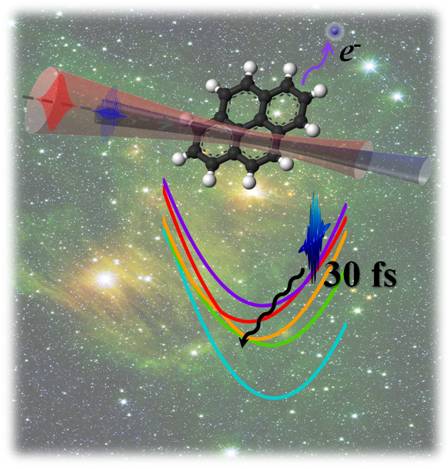
Ultrashort flashes of XUV to understand HAPs: femto-astrochemistry
Alexandre Marciniak, Victor Despré, Thomas Barillot, Vincent Loriot and Franck Lépine (team Dynamics of Excited States), in collaboration with the Max Born Institüt of Berlin, the University of Leiden, the University of Hyderabad and the University of Heidelberg, have published an article entitled “ XUV excitation followed by ultrafast non-adiabatic relaxation in PAH molecules as a femto-astrochemistry experiment “ in the journal Nature Communications.
 The mystery of “diffuse interstellar bands” (DIBs) is one of the most famous illustration of the molecular complexity of interstellar media because species giving birth to these absorption bands have not been yet clearly identified and are still controversial. In this article, authors are interested in the photo-induced ultrafast dynamics of potential candidates for the DIBs: the polycyclic aromatic hydrocarbons (PAHs) thanks to an innovating experimental protocol based on pump-probe spectroscopy. Indeed, this is the first time that extreme ultraviolet (XUV) ultrashort pulses are used to study molecular species as complex as the PAHs thus allowing to resolve the induced dynamics on the femtosecond (1 fs = 10-15 s) time-scale. The excited cations produced under these extreme conditions have revealed an overall relaxation, of few tens of femtoseconds, that involves couplings between electrons and molecular vibrations. Supported by sophisticated ab-initio calculations, these measurements of lifetime in laboratory are compatible with the DIBs spectral width and pave the way to a new field of research: the femto-astrochemistry.
The mystery of “diffuse interstellar bands” (DIBs) is one of the most famous illustration of the molecular complexity of interstellar media because species giving birth to these absorption bands have not been yet clearly identified and are still controversial. In this article, authors are interested in the photo-induced ultrafast dynamics of potential candidates for the DIBs: the polycyclic aromatic hydrocarbons (PAHs) thanks to an innovating experimental protocol based on pump-probe spectroscopy. Indeed, this is the first time that extreme ultraviolet (XUV) ultrashort pulses are used to study molecular species as complex as the PAHs thus allowing to resolve the induced dynamics on the femtosecond (1 fs = 10-15 s) time-scale. The excited cations produced under these extreme conditions have revealed an overall relaxation, of few tens of femtoseconds, that involves couplings between electrons and molecular vibrations. Supported by sophisticated ab-initio calculations, these measurements of lifetime in laboratory are compatible with the DIBs spectral width and pave the way to a new field of research: the femto-astrochemistry.


















